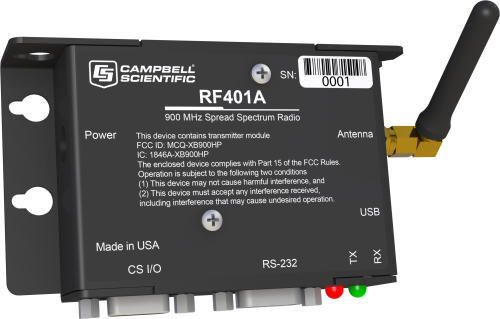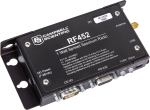
Overview
The RF401A is a 900 MHz radio designed for license-free use in several countries, including the United States and Canada. It provides a hassle-free way to create long-distance wireless links between your computer, data loggers, and measurement devices. The RF401A has a 910 to 918 MHz operating-frequency range and a configurable transmit-power output of 5 to 250 mW.
Campbell Scientific recommends the RF401A radios for existing installations that require compatibility with products such as the RF401, CR206X, CR211X, AVW206, and AVW211. For new installations, Campbell Scientific recommends using the RF407 or RF451.
Note: The image depicts the RF401A with an attached antenna. The antenna is sold separately.
Read MoreBenefits and Features
- Rugged, low-cost transceivers
- Can be used in the field as a transceiver or in the office as the base station
- Individual FCC license not required
- Transmits up to one mile with omnidirectional antenna; up to 10 miles with higher gain directional antennas at ideal conditions
- Settings stored in non-volatile memory
- Frequency-hops over 25 channels avoids interference from other spread spectrum radios
- Optional extended temperature testing
- Faster communication due to elimination of some small "link state packets"
- Ability to have stand-alone RF router/repeaters (up to 8 repeaters)
- Greater immunity to interference and RF collisions by using RF retries
- Reduced power consumption by the data logger, as the radios perform "packet address filtering"
- Designed for use in PakBus networks
- Built-in setup menus allow access to advanced functionality
Images








Detailed Description
The RF401A is a frequency hopping spread spectrum radio designed for 900 MHz license-free ISM band operation. It has a 910 to 918 MHz operating-frequency range and a configurable transmit power output of 5 to 250 mW. It provides one of three selectable active connections including CS I/O, RS-232, and USB. It has a reverse polarity SMA (RPSMA) antenna jack connection. It is over the air compatible with legacy 9XStream products including the RF400, RF401, RF430, CR205, CR206(X), and AVW206.
Compatibility
Communications
The RF401A is over-the-air compatible with the RF401, RF430, CR206, CR206X, and AVW206.
Other Radios
The RF401A is also compatible with the RF400 and CR205, but the communication protocol must be set to transparent. Also, if RF400 and RF401A radios will be in the same RF proximity, do not use 28, 44, 52, 56, or 60 for the RF400 Net Address. RF400 radios with Net Addresses of 28, 44, 52, and 56 interfere with RF401A radios with Net Addresses of 0, 1, 2, and 3, respectively. The RF400 Net Address of 60 interferes with all RF401A Net Addresses.
Campbell Scientific does not recommend using the RF401A in networks containing FGR-115 or RF450 radios.
Transparent and PakBus Protocols
Do not mix RF401A radios using the Transparent protocol setting with RF401A, RF401, RF430, CR206(X), or AVW206 devices using a PakBus protocol setting. This will produce RF traffic without any RF communications. However radios with the PakBus Aware and PakBus Node settings can coexist in the same network.
Data Logger Considerations
| Data Logger | RS-232 | CS I/O |
| CR200(X) |  |
|
| CR800/CR850 |  |
 |
| CR1000 |  |
 |
| CR3000 |  |
 |
| CR5000 |  |
 |
| CR9000(X) |  |
|
| CR300 |  * * |
|
| CR6 |  |
 |
| CR510-PB |  |
|
| CR10X-PB |  |
|
| CR23X-PB |  |
|
| Mixed-array data loggers | ** |
Notes:
*Use a 18663 null modem cable.
**It is possible to connect a mixed-array data logger (e.g., CR10, CR10X, CR23X, 21X, CR7) by using an SC932A or SC105 between the data logger's CS I/O port and the RF401A's RS-232 port.
Specifications
| Radio Type | Frequency Hopping Spread Spectrum (FHSS) |
| Frequency | 910 to 918 MHz |
| Country Used In | US, Canada |
| Transmission Distance |
|
| Power Output | 5 to 250 mW (software-selectable) |
| Receiver Sensitivity | -109 dBm (Campbell Scientific protocols will issue retries wherever a bit error occurs.) |
| Channel Capacity | 7 hop sequences share 25 frequencies. |
| RF Throughput Data Rate | 9.6 kbps |
| Data Rate | 10 kbps |
| Antenna Connector | Reverse Polarity SMA (RPSMA) jack |
| LEDs | Power on, Tx, Rx, diagnostics |
| RS-232 Baud Rate | 1200 to 115200 bps |
| CS I/O Modes | SDC 7, 8, 10, 11, and ME master |
| Average Current Drain |
|
| Power | 9 to 16 Vdc |
| Power Connector | 2.5 mm DC power jack |
| Operating Temperature Range |
|
| Communication Ports |
|
| Service Requirements | Shares frequency with other devices. Must not cause harmful interference to licensed radios. Requires line-of-sight. |
| Dimensions |
11.1 x 6.9 x 2.7 cm (4.4 x 2.7 x 1.1 in.) Dimension are from the tip of antenna connector to other side of case, and from the bottom of case to the top of DB9 connector jack screw. The width includes the thickness of the screw heads on the screws that hold the case together. |
| Weight |
|
Certifications |
|
| United States (FCC Part 15.247) | MCQ-XB900HP |
| Industry Canada (IC) | 1846A-XB900HP |
Downloads
RF401A Series OS v.05 (438 KB) 07-22-2015
Current RF401A and RF411A firmware. Requires the Device Configuration Utility.
Device Configuration Utility v.2.33 (49.6 MB) 07-07-2025
A software utility used to download operating systems and set up Campbell Scientific hardware. Also will update PakBus Graph and the Network Planner if they have been installed previously by another Campbell Scientific software package.
Supported Operating Systems:
Windows 11 or 10 (Both 32 and 64 bit)
Frequently Asked Questions
Number of FAQs related to RF401A: 19
Expand AllCollapse All
-
There is a good chance that they would. However, the RF401A radios have been designed to work with Campbell Scientific data loggers. There are more generic spread-spectrum radios (off the shelf) that are designed to work in this type of configuration.
-
Yes, as do all radios. Adjacent radio equipment operating in the same frequency range can cause interference.
-
The COM220 and the RF401A can coexist on the CS I/O terminal, provided that they are assigned two different SDC addresses.
-
Use of the callback feature is handled under program control by the data logger and is not affected by the RF401A.
-
The RF401A and RF411A have distinct advantages over their predecessors, including greater maximum transmit power, lower average power consumption, improved packaging, and the inclusion of USB, RS-232, and CS I/O on a single device.
- The RF401A is compatible with all of its RF400-series radio predecessors, including the RF400, RF401, and RF430. The RF401A is also compatible with the CR205, CR206X, and AVW206.
- The RF411A is compatible with all of its RF400-series radio predecessors, including the RF410, RF411, and RF431. The RF411A is also compatible with the CR210, CR211X, and AVW211.
-
Yes. All antenna cables introduce a loss in the effective output of the system. The longer the antenna cable, the greater the loss.
-
The RF401A can be powered either from a 12 Vdc source via the field power cable, or from a data logger via the CS I/O port.
-
For an RF401A to communicate with an RF400, the RF401A must be configured to use the transparent communications option.
Case Studies
In August 2012, RESPEC was contracted to provide field instrumentation and early-warning monitoring services at......read more
Articles and Press Releases
Blog Articles
-
Tips to Troubleshoot and Optimize Large RF Networks: Part 3

01-02-2024 Author: Nathanael Wright -
Tips to Troubleshoot and Optimize Large RF Networks: Part 2

12-20-2023 Author: Nathanael Wright -
Tips to Troubleshoot and Optimize Large RF Networks: Part 1

10-31-2023 Author: Nathanael Wright
Privacy Policy Update
We've updated our privacy policy. Learn More
Cookie Consent
Update your cookie preferences. Update Cookie Preferences




